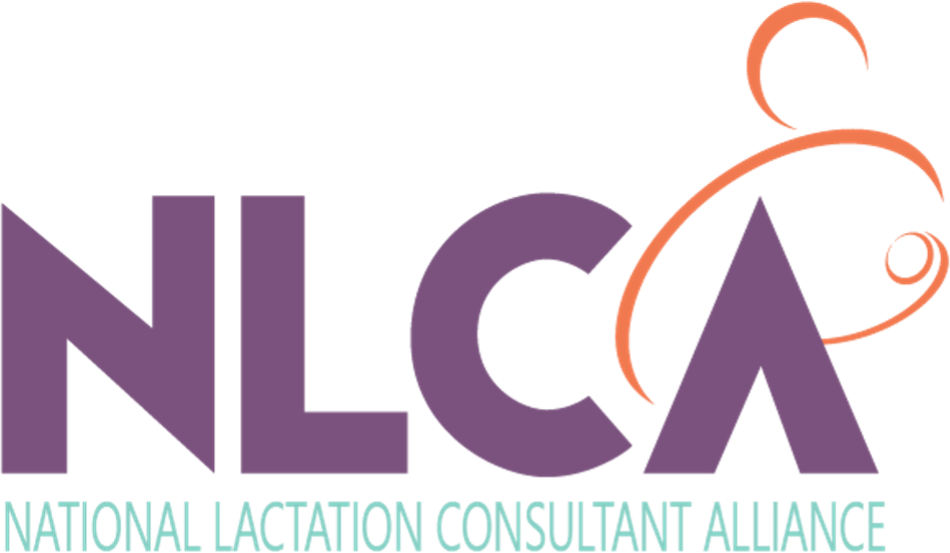Human milk is nature’s first food and is recommended as the exclusive diet during the first six months of life.1
Breastfeeding, breastmilk, and the process of lactation have a profound effect on short and long term maternal and infant health outcomes. It is important to understand the relationship between lack of breastfeeding and diet-related diseases. The following comments are submitted by the National Lactation Consultant Alliance in response to the call for comments by the White House Conference on Hunger, Nutrition, and Health.

5 Pillars
Pillar 1. Improve food access and affordability.
Infants need access to their food and parents need access to clinical lactation care that will help them meet their breastfeeding goals. To meet the breastfeeding goals for the nation and for families to meet their own breastfeeding goals, access to clinical lactation care should be improved. According to the Centers for Disease Control and Prevention (CDC), any breastfeeding has an initiation rate of 83.9% but falls precipitously to 46.3% exclusive breastfeeding at three months, 25.8% exclusive breastfeeding at six months.2 Some states have even lower rates.
One half to one third of newborns receive infant formula before two days of age,2 an intervention that can result in gut dysbiosis and precipitate unwanted health outcomes. In a breastfed infant, consumption of one bottle of formula per day for the first week of life is enough to shift the gastrointestinal microbiology toward proinflammatory taxa.3 Relatively small amounts of formula supplementation of breastfed infants during the first days of life resulted in shifts in infant gut microbiota composition, suggesting that even brief exposure to formula may disrupt normal colonization of the infant gut.4
A reduced or abnormal colonization of the infant gut during the first months of life as can result from infant formula supplementation, can provoke a slower maturation of the epithelial cell barrier functions, and alter gut permeability which can facilitate the invasion of pathogens and foreign or harmful antigens increasing the risk of allergies.5 Not being breastfed is associated with an increased incidence of infectious morbidity, including otitis media, gastroenteritis, and pneumonia, as well as elevated risks of childhood obesity, type 1 and type 2 diabetes, leukemia, and sudden infant death syndrome.6 Among premature infants, not receiving breast milk is associated with an increased risk of necrotizing enterocolitis (NEC).6 Optimal nutrition at the outset of life programs the health trajectory for people across their entire life span.
The occurrence of these diet related diseases can be significantly lowered when breastfeeding families have access to the clinical lactation services of an International Board Certified Lactation Consultant (IBCLC). Breastfeeding encounters many challenges including lack of access to the level of lactation care needed in acute and complex medical situations. Since IBCLCs are licensed in only four states, insurance reimbursement for their services is lacking, leaving many families unable to pay for the services out of pocket.
This disparity in care raises the risk of unwanted health outcomes when breastfeeding ceases due to the inability to pay for needed care. Suboptimal breastfeeding is associated with a greater disease burden among Black and Hispanic populations. Compared with a non-Hispanic white population, a Black population had 1.7 times the number of excess cases of acute otitis media attributable to suboptimal breastfeeding, 3.3 times the number of excess cases of necrotizing enterocolitis, and 2.2 times the number of excess child deaths.7
Compounding the lactation care disparity, the US lacks a national paid family leave policy, forcing mothers back into the work force before lactation has been fully established or breastfeeding challenges remediated. Lack of breastfeeding or the provision of breastmilk can not only result in adverse health outcomes but also costs the US healthcare system billions of dollars for conditions and diseases preventable by breastfeeding.8,9 Access to breastmilk, the initial diet in life, is a national health imperative impacting lifelong health.
Actions to achieve Pillar #1
Actions for the Federal government and Congress
- Enact a national paid family leave policy. The United States, Papua New Guinea, and a few island countries in the Pacific Ocean are the only countries in the United Nations that do not require employers to provide paid time off for new parents. Paid family leave is associated with an increased duration of breastfeeding, a health behavior so important during infancy’s critical developmental window.10
- HRSA should make funds available for the education and training of IBCLCs, especially those with low resources, persons of color, and those from historically marginalized communities. Removing barriers to an adequate IBCLC workforce would allow access to the highest standard of clinical lactation care for all families.
- USDA should require that all WIC agencies have a full complement of breastfeeding peer counselors. Each WIC agency should have at least one IBCLC on staff or access to contracted IBCLCs for situations that exceed the education and skills of the peer counselor. State WIC breastfeeding coordinators should hold the IBCLC credential.
- Legislate all tenets of the International Code of Marketing of Breastmilk Substitutes (the Code).11 The Code was developed as a global public health strategy and recommends curbs on the marketing of breastmilk substitutes, such as infant formula, to ensure that mothers are not discouraged from breastfeeding and that substitutes are used safely if needed. The Code also covers ethical considerations and regulations for the marketing of feeding bottles and artificial nipples. A number of subsequent WHA resolutions have further clarified or extended certain provisions of the Code.
- Reduce the demand for infant formula and protect breastfeeding
- The FDA should eliminate the allowance of structure/function claims on infant formula labels or any marketing materials from infant formula manufacturers or distributors. These claims are typically misleading. “For many claims there is no evidence available to the public, and when the results of randomized trials are made public, we learn that they are limited by small sample sizes, poor follow-up, and provide unpersuasive results.”12 Many of these claims infer equivalency between infant formula and breastmilk, yet in a systematic evaluation of formula trials, there was an almost universal lack of transparency, the trials lacked scientific rigor, formula claims were poorly substantiated, most authors had a conflict of interest, breastfeeding was frequently undermined in the trials, and evidence of publication bias with selective reporting between and within trials was discovered.13 Claims arising from formula trials can contribute to deceptive formula marketing to consumers by narrowing the perceived benefits of breastmilk compared to formula.
- Current regulations do not prevent misleading claims that can ultimately carry health risks for a vulnerable population. Munblit et al., suggest the following: “We propose that any changes to the composition of infant formula should require premarket approval, and the bar for scientific substantiation needs to be significantly higher than that currently used by manufacturers to justify their claims. When a change in infant formula composition has been shown to have a beneficial health effect, that change should be added to Codex standards so that all formula fed infants can benefit. Moreover, using the new ingredient as a health claim before assessment and inclusion in the mandatory Codex standards should be banned. This will avoid misleading consumers and undermining breastfeeding.”15
- Infants and their caregivers lack adequate protection from potentially adverse consequences arising through claims about infant formula. The current regulatory environment is permissive and associated with poorly substantiated and potentially harmful claims. Weak scientific evidence and unreliable claims should be eliminated, and consumers should be given accurate information about infant formula products in a manner that does not undermine breastfeeding.
- The Federal Trade Commission (FTC) needs to enforce its own laws regarding false and deceptive advertising as it relates to the marketing of infant formula. Consumers can be swayed from choosing to breastfeed if they believe the claims made by manufacturers. One study showed that advertisements for formula conveyed an expectation of failure with breastfeeding, and that formula is a solution to fussiness, spitting up, and other normal infant behaviors. Participants reported that the advertisements were confusing in terms of how formula-feeding is superior, inferior, or the same as breastfeeding.15
- Medicaid should reimburse holders of the IBCLC credential when providing clinical lactation services to breastfeeding families who receive Medicaid benefits. Lack of such coverage creates a disparity in care, limits access to clinical lactation services, and can result in premature weaning, placing infants at risk for diseases and conditions preventable by breastfeeding.
Actions for states
- States should license the IBCLC to assure access for those families who cannot afford to pay out of pocket for the level of clinical lactation care that they need. Licensure not only protects the public but helps close the disparity gap in access to clinical lactation services.
- The breastfeeding performance measure should be mandatory as one of the measures for programmatic focus within the Title V Maternal and Child Health Services Block Grant to States.
Pilar 2. Integrate nutrition and health.
Our healthcare system needs to address the nutrition needs for all people including infants. The provision of breastmilk to infants is related to their overall health and disease prevention during infancy and later in life. Breastmilk is a source of bioactive molecules, bacteria, and immune cells working synergistically to program the immunogenic response in the newborn and promote healthy microbial colonization of the infant gut by training the immune system. Breastmilk provision protects the newborn against infection and inflammation at the outset of life, contributing to immune maturation. The role of breastmilk in directing the physiological microbial colonization of the infant gut proceeds during the first 2 years of life, with an altered gut microbiome in the newborn later associated with metabolic compromise in children.16 Maternal diet during lactation affects the composition of breastmilk, glucose tolerance, and weight of the infant. Negative physiological conditions such as obesity, overweight, or overnutrition with energy-dense diets are associated with a pro-inflammatory profile and immune activation in the plasma of the infants after birth. Dietary intervention to increase consumption of fruits and vegetables during lactation in women decreased the proinflammatory markers IFN-γ, TNF-α, IL-6, IL-8, and IL-1β in breastmilk.17
Actions to achieve Pillar 2
- Incentivize birthing hospitals to acquire the Baby Friendly Hospital Initiative18 designation through pay for performance measures from Medicaid.
- Hospitals should demonstrate optimal IBCLC staffing to receive Federal funding. IBCLC staffing guidelines are available from the US Lactation Consultant Association.19
- Obstetric offices, pediatric offices, family practice offices, health clinics, federally funded clinics, and other health delivery settings should eliminate the distribution of formula company-provided gifts or samples.
- Hospitals should cease providing new parents with formula company gifts/discharge bags.
- Medical and nursing schools should integrate lactation information into their respective curricula.
Pilar 3. Empower all consumers to make and have access to healthy choices.
Increasing access to healthy food starts with increasing access to breastfeeding education and optimal support for lactation. Public messaging and educational campaigns regarding breastfeeding may be more effective when conducted through social media platforms.
Actions to achieve Pillar 3
- Create a national text messaging program to reach pregnant and new parents regarding the promotion and support of breastfeeding. Today’s parents are comfortable communicating in the digital expanse, with texting as a preferred manner of communication, and are likely to engage with clinicians though this medium.20
Pilar 5. Enhance nutrition and food security research
While much has been published regarding breastfeeding and human lactation, there are gaps in the knowledge base regarding the physiology of the process, the causes of breastfeeding problems, and how to remediate breastfeeding problems. Federal funding for achieving the national breastfeeding goals within the Healthy People initiative is lacking. Funding for breastfeeding and lactation research should ensure that it is free from commercial conflicts of interest.
Actions to achieve Pillar 5.
- Establish a breastfeeding assessment and data system in the electronic health records
1 https://publications.aap.org/pediatrics/article/129/3/e827/31785/Breastfeeding-and-the-Use-of-Human-Milk
2 https://www.cdc.gov/breastfeeding/data/nis_data/results.html
3 O’Sullivan, A., Farver, M., & Smilowitz, J. T. (2015). The influence of early infant-feeding practices on the intestinal microbiome and body composition in infants. Nutrition and Metabolic Insights, 8 (Suppl 1), 1–9.
4 Forbes, J.D., Azad, M.B., Vehling, L., Tun, H.M., Konya, T.B., Guttman, D.S., et al. (2018). Association of exposure to formula in the hospital and subsequent infant feeding practices with gut microbiota and risk of overweight in the first year of life. JAMA Pediatrics, 172, e181161.
5 Perrier, C., & Corthésy, B. (2011). Gut permeability and food allergies. Clinical & Experimental Allergy, 41, 20–28.
6 Stuebe A. (2009). The risks of not breastfeeding for mothers and infants. Reviews in Obstetrics & Gynecology, 2(4), 222–231.
7 Bartick MC, Jegier BJ, Green BD, Schwarz EB, Reinhold AG, Stuebe AM. Disparities in Breastfeeding: Impact on Maternal and Child Health Outcomes and Costs. J Pediatr. 2017 Feb;181:49-55.
8 Bartick, M, and A. Reinhold. May 2010. “The Burden of Suboptimal Breastfeeding in the United States: A Pediatric Cost Analysis,” Pediatrics, Vol. 125, No. 5.
9 Bartick, M.C., E.B. Schwarz, B.D. Green, B.J. Jegier, A.G. Reinhold, T.T. Colaizy, D.L. Bogen, A.J. Schaefer, and A.M. Stuebe. January 2017. “Suboptimal Breastfeeding in the United States: Maternal and Pediatric Health Outcomes and Costs,” Maternal & Child Nutrition, Vol. 13, Issue 1.
10 Hamad, R., Modrek, S., & White, J. S. (2019). Paid Family Leave Effects on Breastfeeding: A Quasi-Experimental Study of US Policies. American journal of public health, 109(1), 164–166.
11 https://www.who.int/publications/i/item/9241541601
12 Hughes HK, Landa MM, Sharfstein JM. Marketing Claims for Infant Formula: The Need for Evidence. JAMA Pediatr. 2017 Feb 1;171(2):105-106.
13 Helfer B, Leonardi-Bee J, Mundell A, Parr C, Ierodiakonou D, Garcia-Larsen V et al. Conduct and reporting of formula milk trials: systematic review BMJ 2021; 375 :n2202.
14 Munblit D, Crawley H, Hyde R, Boyle R J. Health and nutrition claims for infant formula are poorly substantiated and potentially harmful BMJ 2020; 369 :m875
15 Parry K, Taylor E, Hall-Dardess P, Walker M, Labbok M. Understanding women’s interpretations of infant formula advertising. Birth. 2013 Jun;40(2):115-24.
16 Camacho-Morales, A., Caba, M., García-Juárez, M., Caba-Flores, M. D., Viveros-Contreras, R., & Martínez-Valenzuela, C. (2021). Breastfeeding Contributes to Physiological Immune Programming in the Newborn. Frontiers in pediatrics, 9, 744104.
17 Essa AR, Browne EP, Punska EC, Perkins K, Boudreau E, Wiggins H, Anderton DL, Sibeko L, Sturgeon SR, Arcaro KF. Dietary Intervention to Increase Fruit and Vegetable Consumption in Breastfeeding Women: A Pilot Randomized Trial Measuring Inflammatory Markers in Breast Milk. J Acad Nutr Diet. 2018 Dec;118(12):2287-2295.
18 https://www.babyfriendlyusa.org/
19 Lober, A., Harmon, D., Thomas-Jackson, S.C., & United States Lactation Consultant Association. (2021). Position paper—Professional lactation support staffing in the hospital setting. Clinical Lactation, 12(4), 157-158.
20 Martinez-Brockman JL, Harari N, Pérez-Escamilla R. Lactation Advice through Texting Can Help: An Analysis of Intensity of Engagement via Two-Way Text Messaging. J Health Commun. 2018;23(1):40-51.


